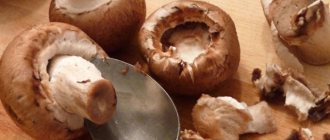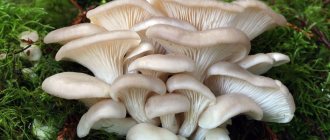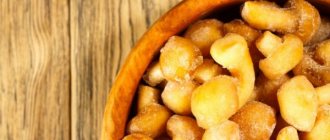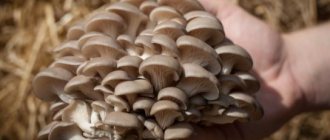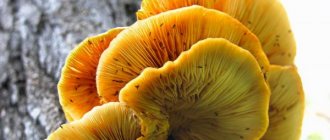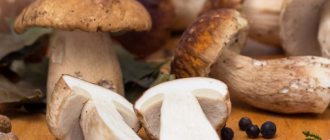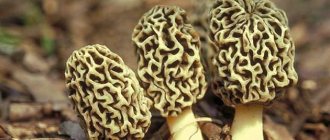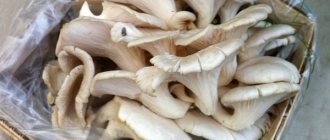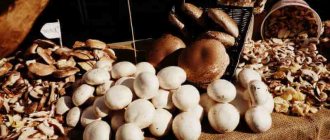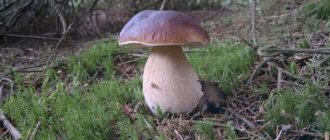Mushroom delicacy
Oyster mushrooms are a real hit of modern mushroom cooking. They taste great and, thanks to widespread artificial cultivation, are very easily available.
Avid mushroom pickers love to find and collect these mushrooms themselves - they are widespread in temperate forests and grow on many types of deciduous trees, hanging from their trunks in multi-story clusters of caps. They can also be found on dead wood and stumps - after all, they are oyster mushrooms and destroy tree trunks, infecting them with rot. There are several varieties of this mushroom, but the oyster mushroom is mainly cultivated and used as food.
Additional cleaning
There are several simple ways to do additional cleaning:
- Blanching: place fresh mushrooms in a container and pour boiling water over them, then leave them in the same hot water for a few seconds. This treatment helps make them more elastic. Usually this manipulation is carried out before marinating.
- Boiling: Place the mushrooms in a saucepan and bring to a boil over high heat. When the water boils, turn it off and let it cool.
- Boiling: place the mushrooms in a container with cold salted water and bring it to a boil. Let cool for 15 minutes and rinse with cold water in a colander.
For your information. Before drying, oyster mushrooms, like other mushrooms, are not washed or boiled. All preparatory manipulations are carried out only on dry mushrooms.
Before freezing, oyster mushrooms should only be wiped with a dry cloth. Do not wet them: this will cause them to absorb excess moisture and lose their taste. Next, they are distributed into small portions and placed in containers. An additional prevention against pests would be to boil and soak mushrooms in a solution of vinegar or citric acid.
Delicious woody miracle
In appearance, oyster mushrooms are difficult to confuse with other mushrooms - they have a large - up to 15 cm and rather plump cap, usually dark gray in color, sometimes mixed with a brown or purple tint. Most often, the cap has a round shape, but it can also be ear-shaped or shell-like.
The legs of these mushrooms are very short and quite hard, so they are not always used as food. The legs are painted white and grow together at the base, forming large single clusters.
You can find oyster mushrooms in the summer, but their main time is autumn. They actively bear fruit from September to the very beginning of winter, often decorating tree trunks already when all the foliage has fallen, and the first snow lies on their caps.
These wonderful woody mushrooms have an excellent taste - they have juicy and tender pulp with a characteristic mushroom aroma, with notes of anise. The taste of cooked oyster mushrooms is not much inferior to boletus or champignons, and their low calorie content allows these mushrooms to be used as an effective dietary food.
Features of the type and useful properties
Oyster mushroom is one of the most delicious, healthy and nutritious mushrooms that grow in groups in a small area. It is recommended to consume young fruits of this species, as they have a distinct, delicate mushroom taste.
The benefits of the product can hardly be overestimated, since during heat treatment it retains not only its taste and exquisite aroma, but also its beneficial properties. When purchasing, it is recommended to choose mushrooms that are light gray in color with a purple tint without any yellow spots on the fruiting body.
This product can be boiled, fried, stewed, salted, pickled. Regardless of the cooking method, oyster mushrooms retain their nutritional properties and excellent mushroom taste. They can be stored dried or frozen for a long time. Due to its beneficial properties, this product began to be grown under artificial conditions. The saturation of nutrients and low calorie content were appreciated by many gourmets who monitor their physical fitness and figure.
You may be interested in:
Growing oyster mushrooms at home Not many people know that you can carry out the process of growing various mushrooms right at home, but this process...Read more...
Types of oyster mushrooms
| View | General signs | Edibility category |
| Oyster | The hat is ear-shaped, matte and smooth, often with rolled edges, up to 25 cm in diameter. The color varies from ashy to dark gray. The leg is lateral and eccentric, up to 3 cm long, often almost absent. It grows from the beginning of summer, but bears fruit en masse from September to November on deciduous trees. | Completely edible |
| Stepnaya | The cap is up to 25 cm in diameter, at first slightly convex, then funnel-shaped. Painted in light yellow shades. The leg is dense and light, barrel-shaped, central or lateral. Grows on the roots and stems of umbrella plants from early spring to early summer. | Completely edible |
| Pulmonary | The hat is fan-shaped, up to 15 cm in diameter, whitish-gray in color, turning yellow over time. The leg is a darker shade, up to 4 cm long, hairy at the base. Grows from May to October on the trunks of deciduous trees. | Completely edible |
| Autumn | The cap is small, up to 5 cm in diameter, with thin and straight edges, covered with a small edge. It is colored in brownish-green or brownish-grayish shades, sometimes with light spots. The leg is lateral and curved, up to 3 cm long. It grows on stumps and woody remains of deciduous trees from September until winter. | Conditionally – edible |
| Horn-shaped | The cap is up to 10 cm in diameter, funnel-shaped, with curved edges. Its color varies from light to ocher-gray. The leg is high, up to 8 cm, and covered with descending plates. It grows from May to early October on the remains of deciduous trees, preferring windbreaks or where there is waste from logging. | Edible |
| Oak | The cap is semicircular, sometimes tongue-shaped, up to 10 cm in diameter. It is colored in brown or grayish-white shades and covered with small scales. The leg is slightly lighter, thick and short - up to 5 cm long. It bears fruit from July to September on the rotting remains of deciduous trees. | Conditionally – edible or inedible |
| Orange | The hat is fan-shaped, up to 8 cm in diameter, with a thick whitish edge. Painted in yellow-orange shades, lighter at the edges. The leg is missing. It bears fruit from September to November on the remains of deciduous and coniferous trees. | Inedible |
| Lemon | The cap is funnel-shaped, with lobed edges, up to 6 cm in diameter. Painted in bright lemon color. The leg is light, with a central or lateral location. Fruits on elm or birch dead wood from May to October. | Edible |
| Covered | The hat is fan-shaped, up to 8 cm in diameter, brownish-gray in color. The color fades greatly in the sun. Grows from April to July on dead aspen and dead wood. | Conditionally – edible |
Cleaning rules: dry, preliminary method
Do I need to clean oyster mushrooms purchased at the market or collected independently in the forest? Certainly! But before the procedure itself, it is important to remember these rules:
- Don't let laziness overcome you. After arriving from the forest (or from the market), from where you delivered a certain amount of these mushrooms to your home, you do not need to forget about them for a long time. Having rested a little, you need to immediately begin freeing them from debris, sand and other inedible inclusions.
- How to clean fresh oyster mushrooms from the forest? Place it on a dry surface and first remove dry, well-disposable debris: twigs, scraps of leaves, straw or grass.
Internal content
Oyster mushrooms are very rich in substances and vitamins beneficial to the body. They contain:
- Vitamin A, necessary for vision, and also promotes bone restoration and healing of mucous membranes.
- B vitamins that help the cell regeneration process and improve the condition of hair and skin.
- Vitamin D is necessary for the formation of bone tissue and maintaining good nerve tone.
- Vitamin PP – prevents the formation of cholesterol plaques.
- Betaine – normalizes the activity of the stomach and intestines.
Oyster mushrooms also contain useful microelements - sodium, phosphorus, zinc, fluorine, potassium and magnesium.
In 100 gr. raw product contains:
- Fats – 0.41 gr.
- Proteins – 3.31 g.
- Carbohydrates – 3.79 g.
Calorie content – 35 kcal.
How to cook oyster mushroom soup
Making delicious, nutritious oyster mushroom soup is easy and simple. This can be the simplest dietary dish or soup with meat broth. In this case, the broth is cooked in advance.
To prepare the soup you will need:
- about 1 kg of oyster mushrooms;
- two potatoes;
- large onion;
- carrots – 2 pcs.;
- horseradish root;
- small pickled cucumber;
- a glass of flour
- egg.
Mushroom soup can be prepared not only from oyster mushroom plates, but also from legs. It turns out a delicious rich broth.
Step-by-step preparation of soup:
- Pour 3 liters of water into a saucepan and place the container on the fire.
- Wash the oyster mushrooms and separate the plates from the stems. Place the mushroom stems into the pan. Add peeled carrots and horseradish root. After boiling, cook the broth over medium heat for an hour.
- Make homemade noodles from flour and eggs. Knead the dough and let it stand for 15 minutes. Roll out thinly and cut into thin noodles.
- Remove vegetables from broth and discard them. You can leave the mushroom stems.
- Finely chop the oyster mushroom caps. Peel the potatoes and cut into small cubes. Add all this to the broth and continue cooking the soup.
- Fry the pre-prepared carrots and onions in butter. Grate the pickled cucumber on a coarse grater or finely chop it. Add to the pan with vegetables.
- 20 minutes after the soup boils, add the fry to the pan. After a couple of minutes, add noodles.
After adding the noodles, cook the soup for no more than 5 minutes.
Remove the pan from the heat and add the chopped herbs to the soup.
Benefits of oyster mushrooms
In their composition, the presence of protein and vitamin D, these mushrooms are similar to dairy products. When consumed regularly, oyster mushrooms are beneficial for:
- Acceleration of metabolic processes
- Cholesterol breakdown
- Reducing the risk of allergic reactions
- Removing toxins from the body
- Preventing the formation of malignant tumors.
- Improved hair and skin condition.
Oyster mushrooms are sometimes recommended as an additional means of combating a number of diseases:
For diabetes mellitus, oyster mushrooms help reduce diastolic pressure, lower blood glucose levels, normalize body weight and free blood vessels from cholesterol.
Oyster mushrooms are recommended for diabetes both in the form of a food product and as a component of medicinal infusions.
Juice squeezed from fresh mushrooms is useful for gastritis. A 10-day course of treatment is used with taking the product 3 times a day, a tablespoon, before meals.
For hypertension, an alcohol tincture of crushed oyster mushroom pulp is used, which is taken a teaspoon before meals.
For thrombophlebitis, mushroom caps soaked in boiling water are used. They are eaten before meals, a tablespoon at a time, in two-week courses.
Oyster mushroom powder is used as a remedy for vitamin deficiency, and an infusion of red wine and mushrooms is useful for the treatment of chronic neuroses and the prevention of cardiovascular diseases.
How to cook oyster mushrooms in sour cream. Oyster mushrooms in sour cream sauce
A recipe for a delicate mushroom sauce that will be an excellent addition to any side dish.
Cooking time: 40 minutes
Sour cream sauce is perfect for many dishes, giving them a delicate taste and appetizing appearance. Lactic acid, which is found in sour cream, will make any product soft and juicy. Therefore, there are quite a lot of recipes for sauces based on sour cream, which indicates its high popularity. Many products turn out delicious in sour cream sauce: meat, liver, squid, meatballs, and of course, mushrooms.
This recipe uses oyster mushrooms, which can be equally successfully replaced with champignons, and cream instead of sour cream. Mushrooms are stewed with onions in a large amount of fatty sour cream, so they become very juicy. It is possible to eliminate hunger and appetite with one serving, because... The dish is quite filling and high in calories. It is served hot as an addition to any side dish: with porridge, pasta, mashed potatoes, etc.
Ingredients
— Oyster mushrooms — 600 grams; — Sour cream — 250 ml; — Onions — 1 pc.; — Garlic — 3 cloves; - Salt and pepper - to taste; - Vegetable oil - for frying
Preparation
Wash the oyster mushrooms and cut into strips. Although if the mushrooms are not large, then they can be left whole
Tip: when buying, choose oyster mushrooms that are dense and elastic, then during cooking they will retain their shape and will look beautiful when served.
Collect and save
Oyster mushrooms are one of the most actively cultivated mushrooms in the world. They are very unpretentious, so many people grow them themselves in their garden plots.
If you have grown the parasites yourself, then you need to collect them when the diameter of the caps reaches about 6 cm. However, their edges should not be completely unfolded. It is very important to remove the fruiting bodies from the substrate correctly - they need to be unscrewed with light circular movements, trying not to leave any residues. Be sure to take the entire splice without breaking it. If you decide to leave a small part of the splice in place so that it grows, nothing will come of it, it will simply die.
If you collect oyster mushrooms in the forest, then the degree of maturity can also be determined by the indicated size of the cap, but mature clumps should not be unscrewed, but cut off with a knife.
It is very important that the fruiting bodies are dry at the time of collection, otherwise you will not be able to store them for a long time. You should not put collected oyster mushrooms in plastic bags - this packaging does not allow air to pass through, which promotes condensation of moisture inside and accelerates the process of spoilage of the mushrooms.
The best container for collected oyster mushrooms is small wooden boxes or baskets. In the refrigerator, at a standard temperature of plus two degrees, the collected mushrooms can be stored for 12 days, but it is best to use them as soon as possible.
Do I need to boil oyster mushrooms before frying? How long to fry oyster mushrooms in a frying pan until done?
Unlike wild mushrooms, veshki are much easier and faster to prepare. How long to fry fresh oyster mushrooms? The duration of their heat treatment varies from 10 to 15 minutes. This time is enough for the mushrooms to be soft, tender, aromatic and completely ready to eat.
Before cooking, the poles must be prepared. They need to be washed thoroughly and dried with a napkin. Even without this, a lot of moisture will be released during frying, so the excess must be eliminated immediately.
It is advisable to cut the poles into cubes or plates. But keep in mind that during the cooking process they will fry and decrease in size.
If forest mushrooms should be boiled until almost half cooked before frying, in the case of veshki this is not necessary. Such mushrooms do not pose any threat to your health.
As practice shows, veshki are fried in odorless, refined vegetable oil. You can also use melted butter. In this case, the mushrooms will acquire a unique aroma and taste.
When should you salt the vegetables and season them with spices during the roasting process? It's better to do this at the very end. The fact is that these mushrooms contain a lot of liquid. And if you salt them right away, then its release will be slowed down. Add all seasonings about 5 minutes before cooking.
On a note! At the very end, the mushrooms can be seasoned with sour cream and cream, sprinkled with herbs. This treat is served as a side dish or as a meal on its own.
Onions go well with mushrooms. How long to fry oyster mushrooms with onions? The duration of their heat treatment remains unchanged - no more than a quarter of an hour. Professional chefs advise sautéing onions separately. You can first fry the weeping vegetable and then fry the vegetables in the same pan. Or you can do this in parallel and connect it at the very end.
Potatoes also go well with fried vegetables. It is unlikely that anyone will be able to refuse such a treat. There is no need to fry all the ingredients together, since potatoes and vegetables have different cooking times. It is better to prepare all the ingredients of the dish separately and then combine 5 minutes before cooking.
On a note! Garlic gives the veshkas a hint of piquancy. You can fry chopped garlic in oil so that it is saturated with garlic aroma. Or you can add this ingredient a few minutes before the end of cooking the mushrooms.
Fried veshki are added not only as a side dish. Often this product becomes one of the components of snack treats and salads. It is not recommended to store cooked mushrooms of this variety for a long time. It is advisable to eat them warm or within 1-2 days. Then the taste of the sticks will only worsen.
Process and clean
The procedure for cleaning collected oyster mushrooms is not at all complicated. The sprouts need to be divided into separate fruiting bodies, then carefully inspect them, identify and remove with a knife areas damaged by insects or rot. Whether to leave the leg or not is up to you to decide. The older and larger the mushroom specimen, the tougher it is. Most oyster mushroom recipes recommend removing the stem, but if you like its tougher consistency, you can leave it in. The stem is also often left on very young specimens of the mushroom. If you decide to leave the leg, then still cut off the very bottom part.
Then each fruiting body should be wiped with a soft cloth, removing various small contaminants.
After the initial cleaning, the mushrooms should be thoroughly rinsed with running water, but this must be done with caution so that the mushrooms do not absorb too much water.
If the fruiting bodies are too heavily contaminated, or you collected them in a known environmentally unfavorable area (which is generally not recommended), then you can soak them in a bowl of clean water for up to 20 minutes.
After this, the mushrooms need to be placed in a colander to drain the water, and then dried by spreading them on a clean, dry towel.
If you bought oyster mushrooms in store packaging, you still need to rinse them with water, especially the lower part of the fruiting body, where the spore-bearing layer is located.
Now these mushrooms can be used to prepare a variety of delicious dishes.
How to clean oyster mushrooms: photos, videos and tips for cleaning mushrooms
19.09.2018
Mushrooms are a very healthy and tasty product. A wide variety of food is prepared from them - sauces, soups, salads, main courses. Oyster mushrooms are considered the most popular to eat. They are collected in the forest from tree trunks, and are also grown at home on sawdust or sunflower seed husks.
Before cooking, mushrooms should be washed thoroughly. But is it necessary and how to clean oyster mushrooms before cooking? - This is a question that many housewives ask. Of course, in order for the finished dish to be tasty, the products should be pre-processed and inedible parts should be removed.
Let's look at everything in more detail in this article.
How to clean oyster mushrooms
You will need
- - oyster mushrooms;
- - sharp knife;
- - colander;
- - a bowl of water.
Instructions
Prepare the mushrooms. They grow in almost any forest. Take a walk to where there are a lot of windbreaks. It is possible that you will find oyster mushrooms there. These mushrooms are often sold in stores, mostly frozen. Despite the fact that oyster mushrooms do not tend to accumulate debris and dry leaves on their caps, it is still necessary to clean and wash them.
https://www.youtube.com/watch?v=WM5ZdqJFLic
If there are a lot of mushrooms, collect some of them in a colander and place them under a strong stream of water. Place the mushrooms washed in this way in a bowl. Rinse the second, third and remaining portions in the same way. In principle, you can soak oyster mushrooms for some time in a bowl of water, and then sort them out with your hands, removing debris, but the option with a colander is more productive.
The cleaning process consists mainly of removing damaged parts. There are also few of them; oyster mushrooms are almost never wormy. Sometimes there are rotten or dried areas. Remove them with a sharp knife. Sticky needles or dry leaves may be accidentally caught. Remove them so they don't end up in the salad.
Of course, they will not bring any harm to eaters, but such ingredients are not pleasant to everyone. After cleaning, you can rinse the mushrooms again. After cleaning, cut the oyster mushrooms. The shape of the pieces depends on what you are going to do with them. You can prepare them in different ways.
At the same time, boiled or stewed oyster mushrooms will last well for several days in the refrigerator, unlike many other mushrooms. If oyster mushrooms are used for salad, cut them into small cubes or strips. They are cut for frying in the same way.
Helpful advice
Starting to prepare for receiving guests a few days in advance, process the mushrooms and prepare a cold appetizer from them. Place the oyster mushrooms in a frying pan with high edges, add chopped garlic and a little water.
For 1 kg of mushrooms, 1 glass of water and 2-3 cloves of garlic are enough. Place the frying pan over medium heat, cover with a lid and simmer until the water boils away.
After this, add 2-3 tablespoons of vegetable oil, spices to taste, a few peas of black pepper, 2 teaspoons (level) of salt and the same amount of sugar. You can add a little cinnamon and cloves. Simmer the dish until done.
Let the mushrooms cool at room temperature. If you are not going to serve them right away, put them in the refrigerator for a day or two. Before serving, remove the mushrooms and let them sit at room temperature.
If you want to organize your own business or simply provide your family with mushrooms, start growing oyster mushrooms . They are quite unpretentious and do not require special care and attention. Your small expenses will more than pay off with delicious and fresh mushrooms.
You will need
- -mycelium;
- -wood logs;
- -saw;
- -copper sulfate;
- - potassium permanganate;
- -sawdust;
- -bark;
- -straw;
- - spruce branches;
- -sackcloth.
Instructions
Prepare logs of wood in spring or autumn, for example, from willow or birch (any deciduous tree will do). The length of the logs is from 0.5 to 1.5 meters, and the thickness is at least 15-25 centimeters.
In the half that will be located on top, use a saw to make cuts or indentations of approximately 3-4 centimeters, the distance between cuts is approximately 20-25 centimeters. Make cuts along the ends of the block as well. Treat the cuts with a solution of copper sulfate and wait 1-2 hours for the wood to dry.
After this, soak the logs in clean water for 2-3 days. Choose a warm and humid place, always shaded, in which the wood will not get wet or dry out. Place a 5-centimeter thick layer of deciduous humus on the ground, if possible, brought from the forest.
Press the log into it a little, sprinkle humus on the sides, but do not fill the cuts. Do not cover the log for the winter, just cover it with snow.
In the first half of May, prepare the logs for laying the mycelium: pour boiling water with potassium permanganate over the cuts (0.5 grams of potassium permanganate per 10 liters of water), then rinse them with clean water and dry them a little. Pour boiling water over the humus, and after a day, place a block of wood on it.
Place mycelium in the cuts and cover them with pre-scalded and cooled sawdust and bark. Cover the log with burlap or fill it with straw/hay. The log must be ventilated. After a month, lightly sprinkle the logs with wood ash. Be sure to moisturize the area around them all month and do not let it dry out.
After two months, remove the burlap or straw/hay and check to see if mycelium has appeared. If a white coating appears in the cuts, that means it is so. Moisten the soil around the log as needed, but under no circumstances get it on the mycelium itself.
Use warm, settled water. Carefully collect mushrooms as they appear, without damaging the mycelium in the cuts. There are at least 2-3 harvests per year. For the winter, cover the log with spruce branches and cover it with snow.
In the spring, after thawing, remove the spruce branches and check the condition of the mycelium.
note
Do not use a chainsaw. If the machine oil used to lubricate it gets into the wood, it can negatively affect the development of the mycelium.
Helpful advice
If mushrooms do not grow in one or more cuts, then the mycelium must be removed from them, disinfected and new mycelium placed. If the entire log is barren, then most likely it is infected with mold. In this case, it must be burned immediately, and its location must be disinfected as thoroughly as possible.
Source:
Advantages and disadvantages of oyster mushrooms
This type of mushroom contains a lot of useful substances for the human body. That is why they are very often eaten.
Let's look at the main advantages of this product:
- They have very low calorie content. But if consumed in large quantities, they can satisfy hunger.
- They contain minerals such as potassium, iron, calcium and iodine.
- Promotes the breakdown of fats.
- Enriched with vitamins: C, D2, B, E and PP. Thanks to them, the product is very similar to meat.
- Remove radioactive substances from the body.
- Reduces cholesterol levels.
Important! As a result of using this product in food, the development of E. coli in the human body is prevented. The human body's resistance to radiation also increases.
When preparing such a product, it is definitely recommended to process it, since it contains chitin, which humans cannot digest. In order to remove chitin, the mushrooms need to be cut very finely and fried well.
Important! One of the most important disadvantages is the not very pronounced mushroom smell. In addition, this type of vegetable products is not resistant to infection by viral diseases. In addition, they are quite difficult to transport, since the fruiting body is very fragile and unstable.
- Author: Maria Sukhorukikh
Rate this article:
- 5
- 4
- 3
- 2
- 1
(0 votes, average: 0 out of 5)
Share with your friends!


